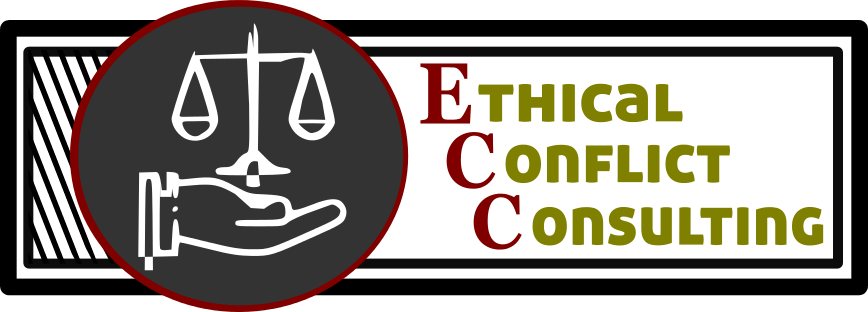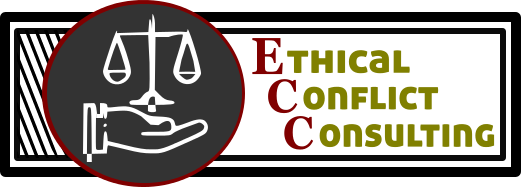Ethical Conflict Consulting (ECC) has selected the following guide to educate general audiences on how conflicts between people in social groups can begin and how situational variables are better factored in your decision-making process. ECC is dedicated to offering educational material that helps you manage conflicts, reduce violence and improve professionalism. Professionalism is improved by increasing levels of safety, efficiency and fairness at workplaces.
The following material is a guide for managing conflict. Before reading the following guide, consider whether the conflict you are managing is between rational people or whether it is better to consider methods for preventing destructive behaviors, like violence or vandalism. This guide serves primarily as a set of valuable considerations to make when solving conflicts between people who are sober and willing to listen to reason.
The following six step guide comes from a professional ethics course offered by William A. Trey Brant, PhD. and William A. Bill Brant, Professional Engineer and lawyer in their course, Your Guide to Ethical Conflict Management for Engineers. For more information on these topics see the latter course via the hyperlink.
Conflict Management: A Concise Guide
Consider the conflict management technique you use and ones you experience from others.
(1) Conflict Management Approaches: You can approach conflicts by (1) being avoidant; (2) being dominant; or (3) compromising (i. through mediation with a third party, ii. arbitration) (4) collaborating, (5) accommodating; or (6) being submissive. Consider alternative approaches other than just the initial approach. (7) Being clueless, confused and inquisitive or expressing surprise is another approach that can be advantageous for initiating the resolution of a dispute. (Note: (7) may facilitate the collaborations at later times). Consider (8) situational conflict management approaches. An employee may first act submissively (6), then avoidant (1) and finally as a bully (2).
(2) Consider the length of time of the dispute. Conflicts preexist newer employees and newer group members.
(3) Consider that the direction and language of any specific dispute may not involve the disputed objects of the communications. For example, the communications over the use of a room, tools or access to something can be a conflict that concerns different things instead, such as power and respect.
(4) Power and Respect: Issues that typically arise under the first appearance of a problem are power and respect. People in workplaces engage in conflict because they feel like they have been treated with less respect than they deserve. People get in conflicts when they think others have unfairly used their power. You get in conflicts when people falsely mistake you as unfairly using your own power. There are ways to convey that you are listening respectfully, though there are times when this is an impossibility. One may think one has too much power or not enough.
(5) Aim of Conflict Management: The goal of conflict management is increasing trust and understanding between the people there and the people interacting with the organization or social group. Increased trust and understanding reduce the likelihood of further conflicts. The most satisfying type of solution to conflicts are collaborations. The approach of collaboration works in the majority of workplace conflicts.
(6) Consider the conflict and other interpretations, miscommunications and deceptions about the conflict. (Note: there is always room for some doubt, although certain issues may be settled) (I) Know whether the conflict at hand is caused by or partially caused by a communication problem (i. request that everyone communicate about the problem as professionally as they can (Note: rarely this is not feasible); ii. allow each individual to communicate effectively (e.g., via emails and voice messages or face-to-face) to assess whether the problem can be solved by attaining knowledge; iii. improve communications with the others (Note: consider the timing of your communications and the messaging system or technology that others prefer to use to communicate with you) (II) consider communicating aggressively and communicating assertively. Try to be assertive without aggression. Assertive communicators do not hesitate from sharing their views. They are respectful to others. (III) maintain your composure when you are angry. Do this by acknowledging at least to yourself that you are angry. Take a minute to cool down and think about what you want to say. Relax and breathe deeply.
Citation: Brant, William Allen. (2021). “Conflict Management.” Ethical Conflict Consulting. October edition. https://ethicalconflictconsulting.com/conflict-management/conflict-management/

